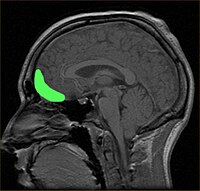
Photo from wikipedia
Impulsive choice is often assessed in rodents using a delay discounting (DD) paradigm in which the delay to a large reinforcer (LR) increases across the session. This procedure allows one… Click to show full abstract
Impulsive choice is often assessed in rodents using a delay discounting (DD) paradigm in which the delay to a large reinforcer (LR) increases across the session. This procedure allows one to test the effects of pharmacological manipulations within a single session. Because discounting is influenced by sensitivity to reinforcer magnitude (SRM) and sensitivity to delayed reinforcement (SDR), applying quantitative analyses (e.g., fitting hyperbolic function) is important for determining the precise behavioral mechanisms being altered following drug administration. One caveat to this approach is that observing increases in SMR/SDR can be difficult (e.g., most rats choose the LR when its delivery is immediate, whereas some rats may show exclusive preference for the small reinforcer [SR] when a delay on the LR is imposed). We utilized a variant of a concurrent-chains procedure in which rats (n = 8) could not show exclusive preference for either reinforcer, thus allowing one to observe increases/decreases in responding at each delay. The NMDAr antagonists MK-801 (0, 0.003, 0.01, 0.03 mg/kg), ketamine (0, 1.0, 5.0, 10.0 mg/kg), and memantine (0, 2.5, 5.0, 7.5 mg/kg) were administered following baseline training because this receptor has recently been implicated in DD. MK-801 (0.03 mg/kg) decreased SRM and SDR. Memantine (7.5 mg/kg) decreased SRM only. These results show that this variant of the concurrent-chains procedure can be used to study the effects of pharmacological manipulations on distinct aspects of DD.
Journal Title: Behavioural Brain Research
Year Published: 2018
Link to full text (if available)
Share on Social Media: Sign Up to like & get
recommendations!